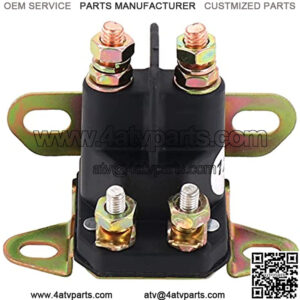The starter motor needs a lot of power to crank a car.
This means that it needs large amounts of current from your car battery.
However, large currents need a large switch, and the ignition switch is too small to handle this. That’s where the starter solenoid comes in.
But what exactly is a starter solenoid?
And what does a solenoid do?
In this article, we’ll explore this magnetic component and how it functions with the starter motor. We’ll also cover some solenoid-related FAQs, including an easy way to get your solenoid issues fixed.
What Is A Starter Solenoid?
The starter solenoid is a powerful electromagnet switch, which is why it’s sometimes called a solenoid switch. It activates the starter motor of an internal combustion engine.
You might also hear it referred to as a starter relay. However, most vehicles have that title reserved for a separate relay in the starter solenoid’s control circuit these days.
Inside the starter solenoid are two coils of wire wrapped around a movable iron core and a set of heavy metal contacts.
Outside, the solenoid usually has three terminals — a small connector and two larger ones.
The small terminal is for the starter control wire that connects to the ignition switch. One large terminal is for the battery cable from the battery’s positive terminal. And the other large terminal is for the wire that sends voltage to the starter motor itself.
Next, let’s see how the solenoid works.
What Does The Starter Solenoid Do?
The starter solenoid has two primary functions — it controls the starter circuit and engages the pinion drive gear.
Let’s take a closer look:
Energizes Starter Circuit
The starter circuit connects the battery to the starter motor. The solenoid acts as the on/off switch for the starter circuit — controlling the burst of electrical current from the battery.
The solenoid itself is controlled by a control circuit, which links it to the ignition switch.
When you activate the ignition switch, the car battery energizes the control circuit. A small current flows from the battery to the starter solenoid, creating a magnetic field around the solenoid coils.
The magnetic field draws in a plunger down the center of the coils, pushing the starter solenoid contacts together. This bridges the gap between the battery and the starter motor, allowing voltage to reach the starter motor.
Note: Here’s the typical flow of current for a control circuit wiring diagram:
Battery ➜ Ignition Switch ➜ Starter Relay (connected to a neutral safety switch) ➜ Starter Solenoid
Engages Pinion Gear
As the solenoid coils pull in the plunger, a lever fork attached to the end of the plunger pushes out the starter pinion gear. This movement meshes the small pinion gear with the larger engine flywheel ring gear.
The pinion gear is connected to the starter motor, which cranks the engine (via the flywheel) once it receives battery power.
It’s important to note that the solenoid coils perform a specific task.
Here’s a breakdown:
What Does Each Solenoid Coil Do?
When the ignition switch is activated, battery power flows to a strong pull-in coil and a weaker holding coil.
The coil’s functions can be divided into three stages:
Pull-in
The pull-in windings generate the magnetic force to draw the plunger down the solenoid core.
Holding
When the plunger reaches its end of travel, it pushes the heavy solenoid metal contacts together, letting battery current flow to the starter motor.
This action also disconnects the pull-in windings.
The current flows through a shunt to the holding windings only — saving some power, delivering more to the starter motor, and reducing heat buildup.
Release
When the ignition switch is released, the magnetic force is reduced, and the holding coil releases the plunger. The starter solenoid contacts open, cutting battery power from the starter motor.
We’ve seen how each solenoid coil functions and know that the solenoid pushes out the pinion gear to crank the engine.
But what happens during engine cranking?
How Does A Solenoid Work With The Starter Motor?
Internal combustion engines require external assistance to start, which is what the starter motor does.
Here’s what happens you turn the key in the ignition:
The starter solenoid receives a small current from the 12 Volt battery. It engages the starter pinion gear with the flywheel ring gear and closes the starter circuit — sending battery voltage to the starter motor.
- With battery power available, the starter motor armature rotates the starter drive shaft and the pinion gear attached to its end. The pinion spins the flywheel, cranking the engine.
- As the flywheel speed picks up, the engine starts, and the pinion gear disengages. The pinion usually has a one-way sprag clutch that allows it to spin independently of the starter drive shaft once the flywheel moves faster, preventing backdrive.
Note: Backdrive is when the flywheel ‘drives’ the pinion instead of the other way round and can cause damage to the pinion gear and starter motor.
About Starter Solenoid
“starter solenoid symptoms”
“starter solenoid relay”
“starter solenoid location”
“starter solenoid replacement”
“starter solenoid diagram”
“starter solenoid connector”

